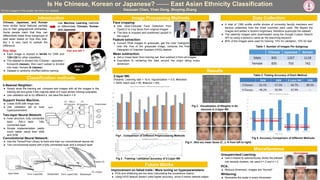Report
Share
Download to read offline

Recommended
Recommended
More Related Content
What's hot
What's hot (13)
Automatic Attendace using convolutional neural network Face Recognition

Automatic Attendace using convolutional neural network Face Recognition
Generative Adversarial Networks : Basic architecture and variants

Generative Adversarial Networks : Basic architecture and variants
Deep Learning For Practitioners, lecture 2: Selecting the right applications...

Deep Learning For Practitioners, lecture 2: Selecting the right applications...
Let's paint a Picasso - A Look at Generative Adversarial Networks (GAN) and i...

Let's paint a Picasso - A Look at Generative Adversarial Networks (GAN) and i...
Similar to CS229 poster
Similar to CS229 poster (20)
A study and comparison of different image segmentation algorithms

A study and comparison of different image segmentation algorithms
Computer Vision - Real Time Face Recognition using Open CV and Python

Computer Vision - Real Time Face Recognition using Open CV and Python
The Search for a New Visual Search Beyond Language - StampedeCon AI Summit 2017

The Search for a New Visual Search Beyond Language - StampedeCon AI Summit 2017
PR-231: A Simple Framework for Contrastive Learning of Visual Representations

PR-231: A Simple Framework for Contrastive Learning of Visual Representations
CS229 poster
- 1. Is He Chinese, Korean or Japanese? —— East Asian Ethnicity Classification Haoxuan Chen, Yiran Deng, Shuying Zhang Introduction Image Processing Methods Face cropping: ● Use Haar-Cascade Face Detection from OpenCV to crop faces from original images ● The face is cropped and positioned upright in the output Feature extraction: ● Convert RGB images to grayscale, get the color histogram over the Hue of the grayscale image, compute the final Histogram of Oriented Gradient (HOG) feature Classification methods k-Nearest Neighbor: ● Simply store the training set, compare test images with all the images in the training set and gives it the majority label of k most similar training examples ● Use validation set to try different k, we have the best k = 8 Support Vector Machine: ● Linear SVM with hinge loss ● Use validation set to tune hyperparameters Two-layer Neural Network: ● Inner structure: fully connected layer - ReLU layer - fully connected layer ● Simple implementation yields much better result than kNN and SVM Data Collection Miscellaneous Unsupervised Learning: ● Use k-means to autonomously divide the dataset into several clusters, we used k = 2 and k = 3 Uncropped Cropped Results Mean subtraction: ● Get a “mean face” from training set, then subtract it from all images ● Equivalent to centering the data around the origin along every dimension PCA: ● Reduce dimension, images are “blurred” Whitening: ● Normalize the scale in every dimension Improvement on failed trails / More tuning on hyperparameters: ● PCA and whitening are too slow (calculating the covariance matrix) ● Using HOG feature doesn’t yield higher accuracy, since it mainly detects edges ● A total of 1380 profile profile photos of university faculty members and famous celebrities from the three countries were used. We flipped the images and added a random brightness, therefore quadruple the dataset. ● The celebrity images were downloaded using the Google Custom Search API by using a person’s name as the searching keyword. ● 80% of the images were used for training; 10% for validation; 10% for test. Chinese, Japanese, and Korean have similar facial features partially due to their geographical similarities. Some people claim that they can differentiate these three subgroups of east asian based on how they look. But it is very hard to eyeball the difference. Future Works Use Machine Learning methods to differentiate Chinese, Korean and Japanese Can you tell ? BEATS ME... Key idea: ● Each Image is resized to 64×64 for CNN and 128×128 for other classifiers ● The dataset is divided into Chinese / Japanese / Korean(3 classes), then each subset is divided into male / female (6 classes) ● Dataset is randomly shuffled before training Table 1. Number of Images Per Subgroup *All the images in this poster are from our dataset Convolutional Neural Network: ● Use the TensorFlow Library to build and train our convolutional neural net ● Two convolutional layers with a fully connected layer and a dropout layer Fig 3 . Visualization of Weights in 64 neurons in 2-layer NN Fig 2 . Training / validation accuracy of 2-Layer NN 2-layer NN: (Params: Learning rate = 1e-4, regularization = 0.5, #iteration = 3500, batch size = 50, #neuron = 64) Table 2. Testing Accuracy of Each Method Fig 5. Accuracy Comparison of Different Methods Baseline (3 classes) Baseline (6 classes) Fig1 . Comparison of Different Preprocessing Methods Fig 4 . (Not so) mean faces (C, J, K from left to right)